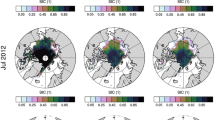Abstract
A thermodynamic sea ice model that has been numerically structured to take time steps on the order of a week has been shown to be sensitive to time step size. This sensitivity was caused by the extrapolation of initial ice growth rates over the long time step. A new parameterization of new sea ice growth on open ocean and in leads that can be used over a large range of time step sizes (at least from 0.3 to 12 days) is described here. In this parameterization new sea ice growth is computed as a power law function of the initial energy deficit in the ocean. This power law takes into account the rapid reduction of the ice growth rate as the sea ice gets thicker, and therefore reduces sensitivity to time step size. Tests of this parameterization show that this method does a good job of simulating the rate of new ice growth when compared to data from Mawson, Antarctica, and is relatively insensitive to the length of the time step.
Similar content being viewed by others
References
Allison I (dy1981) Antarctic sea ice growth and oceanic heat flux. Sea level, ice, and climatic change (Proceedings of the Canberra Symposium. 1979), IAHS Publ no 131, pp 161–170
Barry RG, Henderson-Sellers A, Shine KP (1984) Climate sensitivity and the marginal cryosphere. In: JE Hansen, T Takahashi (eds) Climate processes and climate sensitivity, American Geophysical Union, Washington, DC, pp 221–237
Bentley CR (1984) Some aspects of the cryosphere and its role in climatic change. In: JE Hansen, T Takahashi (eds) Climate processes and climate sensitivity, American Geophysical Union, Washington, DC, pp 207–220
Hibler WD (1979) A dynamic thermodynamic sea ice model. J Phys Oceanogr 9:815–846
Hibler WD (1980) Sea ice growth, drift, and decay. In: SC Colbeck (ed) Dynamics of snow and ice masses, Academic, New York, pp 141–209
Hibler WD (1984) The role of sea ice dynamics in modeling CO2 increases. In: JE Hansen, T Takahashi (eds) Climate processes and climate sensitivity, American Geophysical Union, Washington, DC, pp 238–253
Ledley TS (1985a) Sensitivity of a thermodynamic sea ice model with leads to time step size. J Geophys Res 90:2251–2260
Ledley TS (1985b) Sea ice: Multiyear cycles and white ice. J Geophys Res 90:5676–5686
Maykut GA (1978) Energy exchange over young sea ice in the central Arctic. J Geophys Res 83:3646–3658
Orvig S (ed) (1970) World survey of climatology, vol 14, climate of the polar regions. Elsevier, Amsterdam, p 370
Parkinson C, Washington W (1979) A large-scale numerical model of sea ice. J Geophys Res 84:311–337
Ruddiman WF, McIntyre A (1981) Oceanic mechanisms for amplification of the 23,000-year ice volume cycle. Science 212:617–627
Schutz C, Gates WL (1971) Global climate data for surface, 800 mb, 400 mb: January. Rep R-915-ARPA, Rand Corp, Santa Monica, CA, p 182
Schutz C, Gates WL (1972) Global climate data for surface, 800 mb, 400 mb: July. Rep R-1029-ARPA, Rand Corp, Santa Monica, CA, p 180
Schutz C, Gates WL (1973) Global climate data for surface, 800 mb, 400 mb: April. Rep R-1317-ARPA, Rand Corp, Santa Monica, CA, p 192
Schutz C, Gates WL (1974) Global climate data for surface, 800 mb, 400 mb: October. Rep R-1425-ARPA, Rand Corp, Santa Monica, CA, p 192
Semtner AJ Jr (1976) A model for the thermodynamic growth of sea ice in numerical investigations of climate. J Phys Oceanogr 6:379–389
Thompson SL, Warren SG (1982) Parameterization of outgoing infrared radiation derived from detailed radiative calculations. J Atmos Sci 39:2667–2680
Thorndike AS, Rothrock DA, Maykut GA, Colony R (1975) The thickness distribution of sea ice. J Geophys Res 80:4501–4513
Washington WA, Semtner A, Parkinson C, Morrison L (1976) On the development of a seasonal change sea ice model. J Phys Oceanogr. 6:679–685
Zwally HJ, Comiso JC, Parkinson CL, Campbell WJ, Carsey FD, Gloersen P (1983) Antarctic sea ice 1973–1976: Satellite passive-microwave observations. National Aeronautics and Space Administration, Washington, DC, p 206
Author information
Authors and Affiliations
Rights and permissions
About this article
Cite this article
Ledley, T.S. Development of a new sea ice growth and lead parameterization. Climate Dynamics 2, 91–100 (1987). https://doi.org/10.1007/BF01054492
Received:
Accepted:
Issue Date:
DOI: https://doi.org/10.1007/BF01054492




